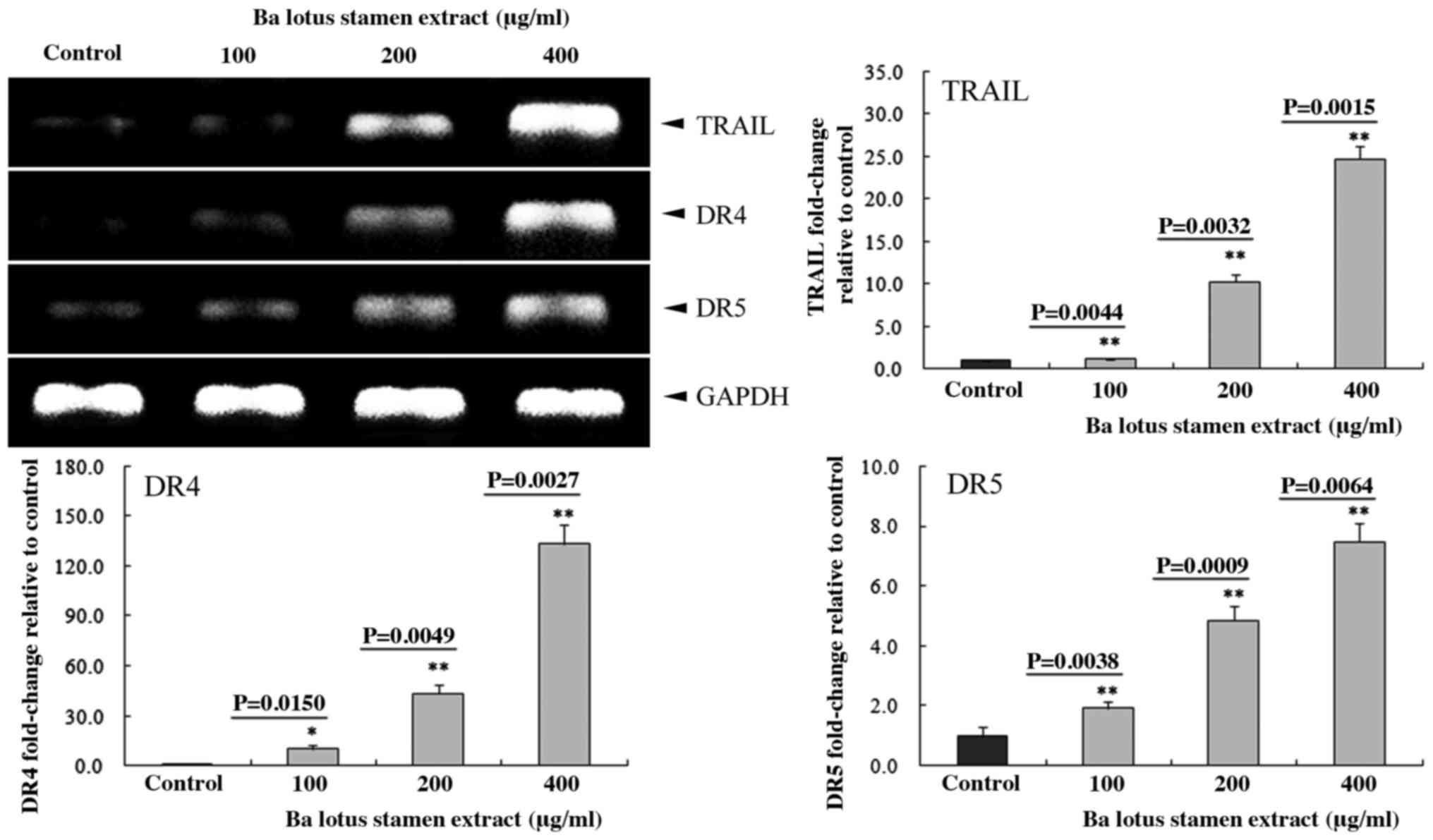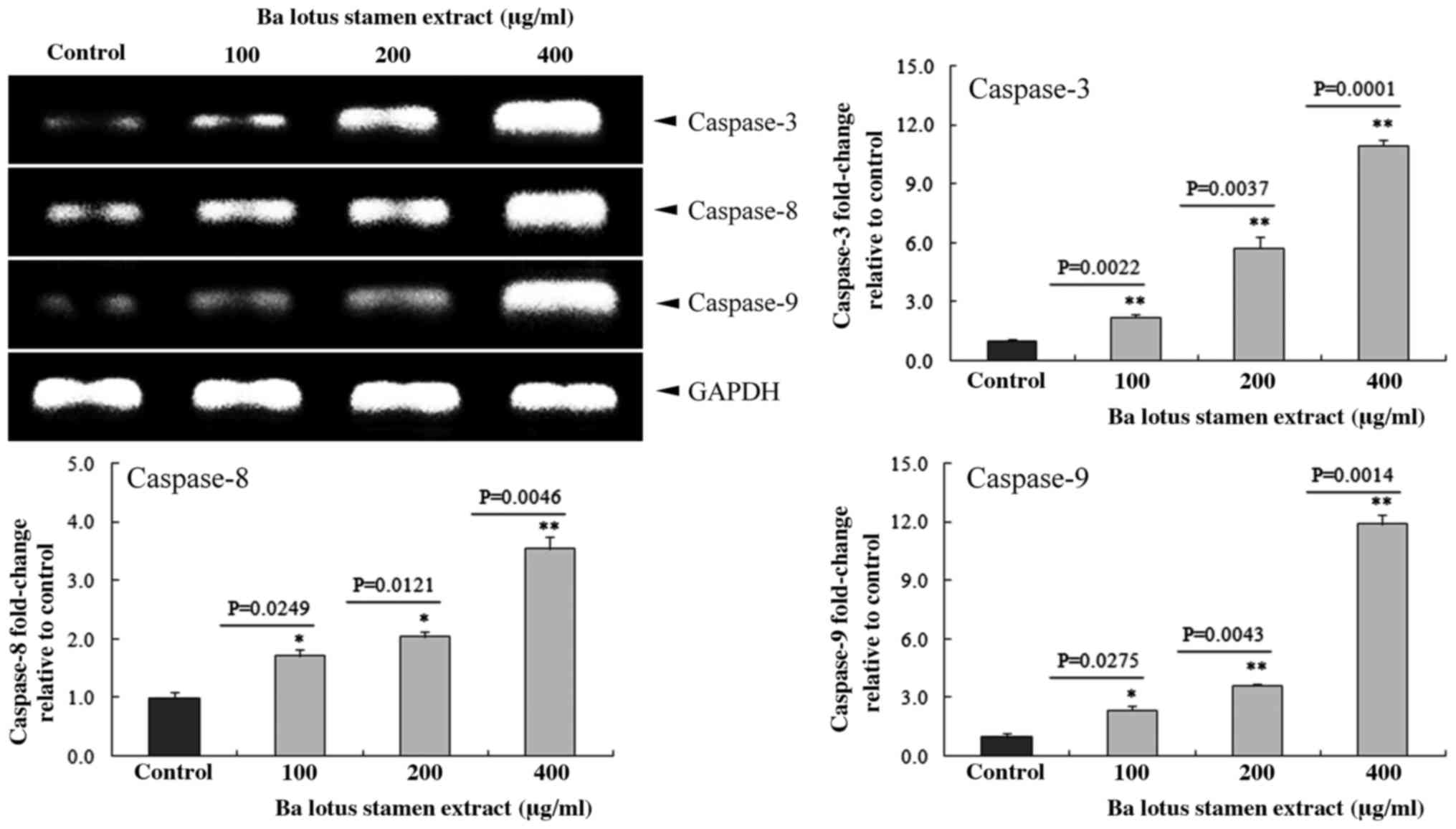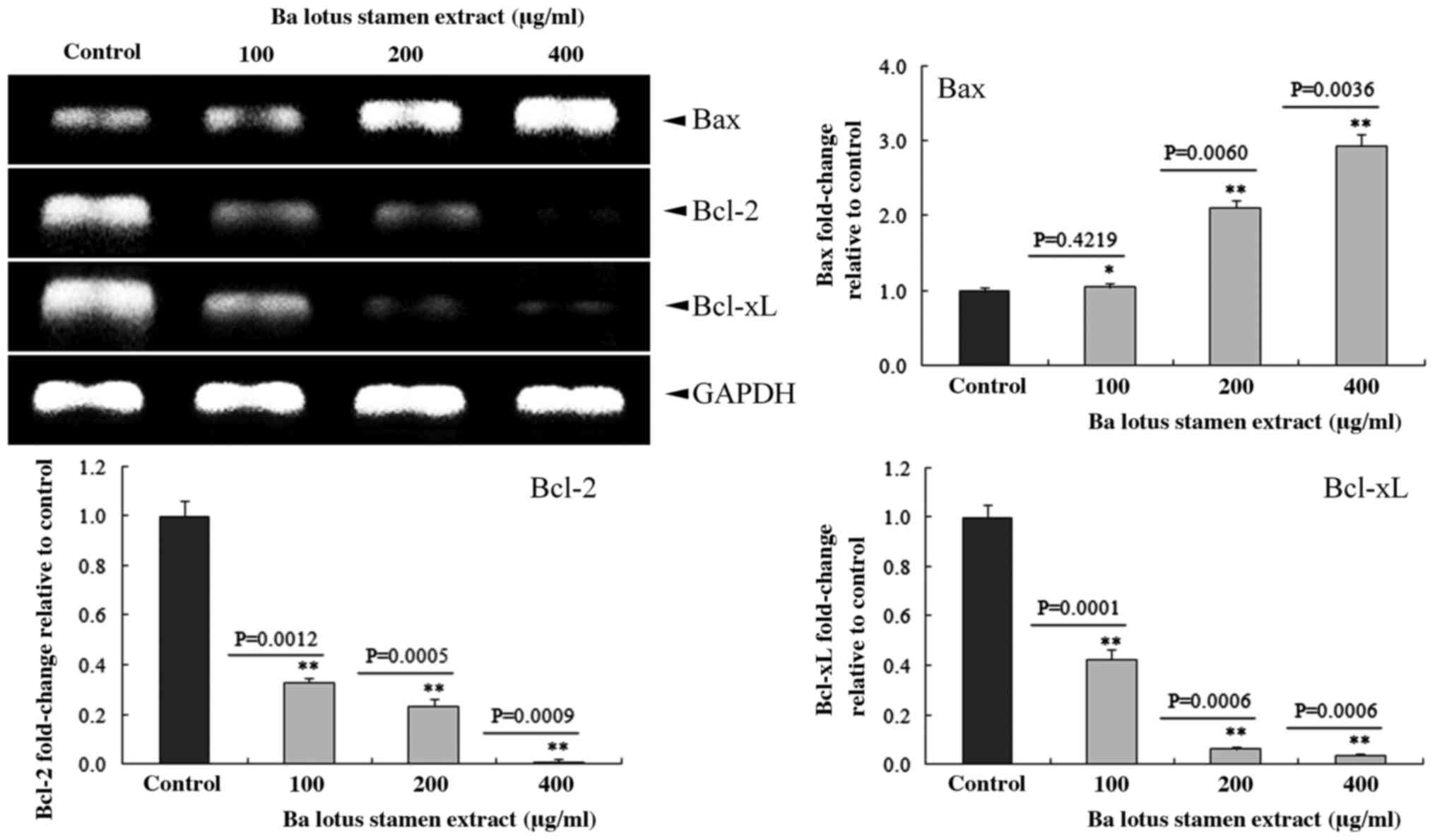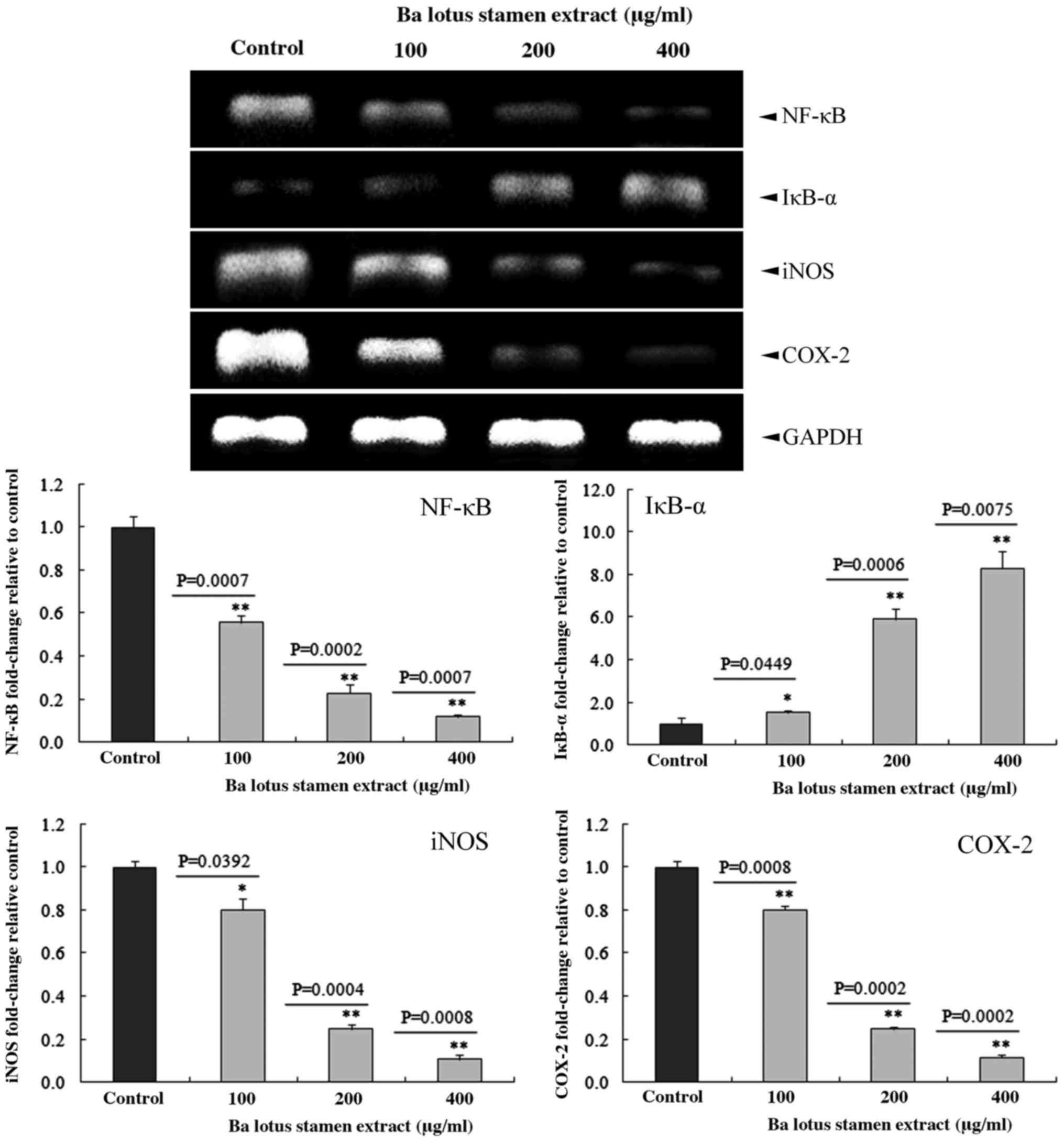Anticancer activity of Nelumbo nucifera stamen extract in human colon cancer HCT-116 cells in vitro
- Authors:
- Published online on: December 28, 2016 https://doi.org/10.3892/ol.2016.5547
- Pages: 1470-1478
Abstract
Introduction
Colorectal cancer (CRC) is one of the most frequently diagnosed cancers in the world. In the USA, CRC is the third most common malignant tumor, and there was an estimated 103,170 new cases of CRC throughout the country in 2014 (1). Previously, CRC has become the fourth most common malignant tumor, and the third leading cause of cancer-associated mortality in China (2). CRC also shows a high level of metastasis, and 25% of CRC patients that present with metastatic disease have a 5-year survival of only 10% (3). Surgical resection plus chemotherapy and/or radiation therapy are effective treatments for CRC in the clinic. However, chemotherapy and radiation therapy are commonly associated with serious side effects, including bone marrow suppression, nausea and vomiting, hair loss and loss of appetite (3). Enhancement of cancer cell apoptosis is a good strategy in the clinical treatment of cancer (4).
As classic apoptosis-associated factors, the B-cell lymphoma 2 (Bcl-2) family plays an important role in the regulation of cell apoptosis. The Bcl-2 family is generally divided into anti-apoptotic factors, including Bcl-2, Bcl-extra large (Bcl-xL) and Bcl-W, and proapoptotic factors, including Bcl-2-associated X protein (Bax), Bcl-2 associated agonist of cell death, Bcl-2 interacting mediator of cell death (Bim), Bcl-2 antagonist/killer 1 and p53 upregulated modulator of apoptosis (5,6). In the extrinsic apoptosis pathway, the cell death receptor Fas/Fas ligand (FasL) system plays an important role to induce receptor-ligand mediated cell apoptosis, and also regulates the Fas-associated death domain (FADD) and caspase-8-mediated cell apoptosis (7). In apoptosis, the depolarization of the inner mitochondrial membrane potential causes the release of cytochrome c (Cyto c) into the cytosol (8). The released Cyto c also activates caspases by formation of a complex that induces the activation of apoptotic protease-activating factor-1 (Apaf-1) and procaspase-9. Furthermore, activated caspase-8 and −9 cleaved the final executioner caspase-3, and directly induced the chromatin condensation and DNA fragmentation to promoting apoptosis in cells (9,10).
Traditional herbal medications are commonly used to treat colon cancer in the clinic (11–13). Lotus is traditionally used as a Chinese folk medicine to disperse the summer heat, and has shown numerous health benefits and pharmacological activities, including antioxidant (14), antidiarrheal (15), antiviral (16), anti-obesity (17–20), anti-angiogenic (21), hepatoprotective (22), immunomodulatory (23) and insulin secretagogue activity (24). Therefore, the present study focused on investigating the potential anticancer activity of Nelumbo nucifera (Ba lotus) stamen ethanol crude extract (BLSEE), and also to elucidate the mechanisms underlying its anticancer effects in human colon carcinoma HCT-116 cells.
Materials and methods
Chemical reagents
TRIzol reagent, OligodT18 primer, murine Moloney leukemia virus (MMLV) reverse transcriptase, RNase inhibitor, ethidium bromide (EtBr), and agarose were purchased from Invitrogen (Thermo Fisher Scientific, Inc., Waltham, MA, USA). All other reagents were of analytical grade and purchased from Sigma-Aldrich (Merck Millipore, Darmstadt, Germany).
BLSEE preparation
Fresh Ba lotus stamen purchased from Chongqing Enterprise Engineering Research Center of Ba-lotus Breeding and Deep Processing (Chongqing, China) were freeze-dried and then ground into a fine powder. In total, 100 g of powdered Ba lotus stamen was extracted twice with 1,000 ml ethanol (70%, v/v) at 50°C for 1 h. Subsequent to filtering, the sample extraction solution was condensed by vacuum rotary evaporator (Büchi Rotovapor RE 111; Büchi Labortechnik AG, Flawil, Switzerland) at 37°C, freeze-dried and stored at −80°C until further study.
Cell culture
Human colorectal HCT-116 cancer cells were purchased from the American Type Culture Collection (Manassas, VA, USA). The cells were routinely maintained in RPMI-1640 medium supplemented with 10% (v/v) FBS, and 1% penicillin-streptomycin in a humidified CO2 incubator (model 3154; Forma Scientific, Inc., Marietta, OH, USA) with a 5% CO2 atmosphere at 37°C.
Cell viability assay
Cell viability was measured using an MTT assay. HCT-116 cells were seeded in 96-well plates (Nalge Nunc International, Rochester, NY, USA) at a density of 1×104 cells/well. Following a 24-h incubation, the cells were treated with the various concentrations (100, 200 and 400 µg/ml) of BLSEE for 24 h. Following incubation with BLSEE 0.5 mg/ml of MTT reagent (100 µl) was added to each well and the cells were incubated in a humidified incubator at 37°C to allow the MTT to be metabolized. At total of 4 h later, formazan crystals were dissolved with dimethyl sulfoxide (100 µl in each well). Absorbance of the samples was measured at a wavelength of 540 nm using a microplate reader (model, 680; Bio-Rad Laboratories, Inc., Hercules, CA, USA).
Flow cytometry analysis
The BLSEE-treated HCT-116 cells were first collected following digestion with trypsin, washed twice with cold PBS, and resuspended in 2 ml PBS. The DNA contents of the treated cells were stained with propidium iodide (PI) using a DNA staining kit (CycleTEST™ PLUS DNA reagent kit; Becton Dickinson, Franklin Lakes, NJ, USA), according to the manufacturer's protocol. Fluorescence intensity was determined using a FACScan flow cytometer (EPICS XL-MCL, Beckman Coulter KK, Brea, CA, USA) and analyzed using CellQuest software (Becton Dickinson).
Reverse transcription-polymerase chain reaction (RT-PCR) assay
Total RNA was isolated from BLSEE-treated HCT-116 cells using TRIzol reagent, according to the manufacturer's protocol, and centrifuged at 12,000 × g for 15 min at 25°C following the addition of chloroform (200 µl). Isopropanol was added to the supernatant at a 1:1 ratio and the RNA was pelleted by centrifugation at 12,000 × g for 15 min at 4°C. Subsequent to washing with ethanol, the RNA was solubilized in diethyl pyrocarbonate-treated RNase-free water and quantified by measuring the absorbance at 260 nm using a UV-1750 spectrophotometer (Shimadzu, Kyoto, Japan). Equal amounts of RNA (1 µg) were reverse transcribed in a master mix containing 1X reverse transcriptase buffer, dNTPs (1 mM), oligodT18 primers (500 ng), MMLV reverse transcriptase (140 U), and RNase inhibitor (40 U) for 45 min at 42°C. PCR was then performed in an automatic thermocycler (Bioneer, Daejeon, South Korea) for 40 cycles (94°C for 5 min, 58°C for 30 sec, and 72°C for 90 sec) followed by a 10 min extension at 95°C. The primer sequences as presented at Table I. The PCR products were separated in 2% agarose gels and visualized by EtBr staining. GAPDH was used for normalization of the results. Gene expression was quantified using ImageJ software (version 1.44; National Institutes of Health, Bethesda, MD, USA) and results presented as fold change compared to the control group.
Statistical analysis
Data are presented as the mean ± standard deviation. Differences between the mean values for individual groups were assessed by a one-way analysis of variance with Duncan's multiple range tests. P<0.05 was considered to indicate a statistically significant difference. The SAS v9.1 statistical software package (SAS Institute Inc., Cary, NC, USA) was used for the statistical analysis.
Results
BLSEE reduced HCT-116 cancer cell growth
As shown in Table II, BLSEE significantly inhibited the colon cancer HCT-116 cell growth in vitro in a dose-dependent manner. At a high dose of 400 µg/ml, BLSEE showed the highest inhibition activity of HCT-116 cells (86.3%; P=0.0002), compared with doses of 100 (P=0.0006) and 200 µg/ml BLSEE (P=0.0017).
Table II.Growth inhibition of human HCT-116 colon cancer cells by Ba lotus stamen extract as evaluated by MTT assay. |
BLSEE induced the apoptosis in HCT-116 cancer cells
Flow cytometry analysis revealed that BLSEE treatment was able to promote apoptosis in HCT-116 cells. As shown in Fig. 1, the BLSEE treatment significantly increased the proportion of apoptotic cells to 10.2 (P=0.0043), 19.7 (P=0.0032) and 41.3% (P=0.0020) compared with the non-treated cells (2.3%).
Effect of BLSEE on the expression of Fas, FasL, tumor necrosis factor (TNF)-related apoptosis-inducing ligand (TRAIL), death receptor 4 (DR4) and death receptor 5 (DR5) in HCT-116 cells
Following treatment with various doses of BLSEE, the mRNA levels of Fas (P=0.0019 at 400 µg/ml) and FasL (P=0.0003 at 400 µg/ml) were upregulated in HCT-116 cells (Fig. 2). In addition, 400 µg/ml of BLSEE significantly upregulated the mRNA levels of TRAIL (24.7-fold; P=0.0015), DR4 (133.2-fold; P=0.0027) and DR5 (7.5-fold; P=0.0064) compared with non-treated HCT-116 cells (Fig. 3).
Effect of BLSEE on the expression of caspases 3, 8 and 9 in HCT-116 cells
The effect of BLSEE on the mRNA caspase family, including caspases 3, 8 and 9 in HCT-116 colon cancer cells was determined by RT-PCR assay. BLSEE treatment significantly increased the mRNA expressions of these caspases in HCT-116 cells in a dose-dependent manner (Fig. 4). The highest dose (400 µg/ml) of BLSEE also increased the mRNA levels of caspase-3 (10.9-fold; P=0.0001), caspase-8 (3.5-fold; P=0.0046) and caspase-9 (11.9-fold; P=0.0014) compared to the non-treated HCT-116 cells.
BLSEE modulated the expressions of Bcl-2, Bcl-xL and Bax in HCT-116 cells
As shown in Fig. 5, BLSEE treatment dose-dependently reduced the expression of Bcl-2 and Bcl-xL in HCT-116 cells. At the highest dose of 400 µg/ml, BLSEE significantly reduced the mRNA levels of Bcl-2 (98.9%; P=0.0009) and Bcl-xL (96.3%; P=0.0006) compared to the non-treated HCT-116 cells, respectively. By contrast, 400 µg/ml of BLSEE also enhanced the Bax levels of mRNA (2.9-fold; P=0.0036) compared to non-treated HCT-116 cells.
BLSEE modulated the expression of matrix metalloproteinase (MMP)-2, MMP-9, TIMP metallopeptidase inhibitor 1 (TIMP-1) and TIMP metallopeptidase inhibitor 2 (TIMP-2) in HCT-116 cells
As shown in Fig. 6, BLSEE treatment dose-dependently reduced the expression of MMP-2 and MMP-9 in HCT-116 cells. At the highest dose of 400 µg/ml, BLSEE significantly reduced the mRNA levels of MMP-2 (95.8%; P=0.0002) and MMP-9 (85.9%; P=0.0002) compared with non-treated HCT-116 cells. By contrast, 400 µg/ml of BLSEE was also able to enhance the mRNA levels of TIMP-1 (17.6-fold; P=0.0004) and TIMP-2 (73.6-fold; P=0.0002) compared with non-treated HCT-116 cells.
BLSEE modulated the expression of inducible nitric oxide synthase (iNOS), cyclooxygenase 2 (COX-2), nuclear factor (NF)-κB and inhibitory κBα (IκBα) in HCT-116 cells
BLSEE treatment significantly decreased the mRNA levels of iNOS, COX-2 and NF-κB, and increased the IκBα levels in HCT-116 cells (Fig. 7). Subsequent to treatment with a dose of 400 µg/ml BLSEE, the mRNA levels of iNOS, COX-2 and NF-κB were decreased by 89.2 (P=0.0008), 88.3 (P=0.0002) and 87.9% (P=0.0007) compared with the non-treated HCT-116 cells. In addition, BLSEE also increased the mRNA levels of IκBα (8.3-fold; P=0.0075) compared with non-treated HCT-116 cells.
Discussion
In the present study, BLSEE treatment was found to significantly inhibit the cell proliferation, and also increase the proportion of cells in the sub-G1 phase in HCT-116 cancer cells. These results suggested that BLSEE may induce apoptosis in HCT-116 cells.
Based on these observations, the mRNA expression of apoptosis-associated death receptors, including Fas and FasL, was analyzed in HCT-116 cells using an RT-PCR assay. Fas and FasL are apoptosis inducers, and play an important role during death receptor-induced extrinsic apoptosis in cells (25). The present study found that following incubation with 24 h of BLSEE, the mRNA levels of Fas and FasL were each significantly increased in HCT-116 cells. Activation of Fas/FasL was able to recruit FADD and death domain, and subsequently induce the activation of caspases 8, 9 and 10 to promote cellular apoptosis (26). In addition, the present study also observed that mRNA levels of TRAIL, DR4 and DR5 were increased by BLSEE treatment for 24 h. TRAIL binds to TRAIL receptors, such as DR4 and DR5, to form a trimeric complex, which leads to the recruitment of FADD, an adaptor molecule that recruits and activates caspase-8 (27,28).
The caspase signaling cascade is a key event in extrinsic and intrinsic cell apoptosis, which is characterized by the activation of caspase-8 and caspase-9, respectively (9). Caspase-8 is a main initiator caspase in Fas signaling, and is recruited to the activated Fas receptor, as well as inducing death receptor-induced cell apoptosis (29). In addition, caspase-9 is an apoptosis effector molecule in the mitochondrial channel and starts programmed cell death subsequent to activation (10). Activated caspase-8 and caspase-9 are each able to activate caspase-3, which is an executor of apoptosis that subsequently induces apoptosis in cells (8). In the present study, it was found that the mRNA levels of caspases 3, 8 and 9 were significantly increased in BLSEE-treated HCT-116 cells.
It was also found that BLSEE treatment was able to modulate the mRNA expression of apoptosis-associated Bcl-2 family members in HCT-116 cells. BLSEE treatment significantly reduced the mRNA levels of anti-apoptotic Bcl-2 and Bcl-xL in HCT-116 cells. Bcl-2 and Bcl-xL are generally known as factors that prevent the release of Cyto c from the mitochondria into the cytosol, inhibiting apoptosis and promoting the survival of cells (5). Bcl-xL can also block the formation of the apoptosome, which converges with Cyto c, Apaf-1 and procaspase-9, to reduce the activation of caspase-3 and inhibit apoptosis (30,31). The balance between anti-apoptosis and pro-apoptosis factors may affect the occurrence of apoptosis in cells, and is also associated with the success or failure of chemotherapy in cancer patients (32). By contrast, BLSEE was able to increase the mRNA levels of Bax, which is a pro-apoptotic protein, to promote apoptosis in cells (5,7). The activated Bax may be directly engaged by Bim to promote apoptosis in cells (33). In addition, Bax also induces the activation of caspase-8 and the release of Cyto c from the mitochondria, resulting in the cleavage of caspase-9, and contributes to the activation of executor caspase-3 (5,34). The present results suggest that the BLSEE may modulate the balance between anti-apoptosis and pro-apoptosis factors, in particular enhancing the expression levels of pro-apoptotic Bax to promote apoptosis in HCT-116 cells.
MMPs are an important family of proteolytic enzymes that not only contribute to organ development and tissue regeneration, but also show an extremely important role in the regulation of tumor invasion, angiogenesis and metastasis (35,36). In particular, MMP-2 exhibits a key role in the progression of colon cancer and the promotion of metastasis (37). Additionally, overexpression of MMP-9 is closely associated with poor prognosis in patients with colon cancer (38). Numerous studies have reported that herbs extracts were able to inhibit the migration or invasion of colorectal cancer cells by downregulating MMP-2 and MMP-9 in vivo (39–41). In the present study, it was found that BLSEE significantly reduced the expression of MMP-2 and MMP-9, and also increased the activation of TIMP-1 and TIMP-2 in HCT-116 colon cancer cells. As natural MMP inhibitors, TIMP-1 and TIMP-2 are able to inhibit the activation of MMP-2 and MMP-9 to reduce the invasion and metastasis in patients with colon cancer (42,43). Subsequent to treatment with BLSEE, the expression levels of TIMP-1 and TIMP-2 were significantly increased. Furthermore, maintaining an increased level of TIMP-1 and TIMP-2 may improve the poor survival of CRC patients (37,44).
Over activation of NF-κB has been found in numerous human cancers (45,46). NF-κB promotes cell proliferation, negatively regulates cell apoptosis (47), reduces cell death in tumorigenesis (48) and induces the inflammatory reaction in human disease (46,49). The activation of NF-κB is able to reduce TNF-α-induced cell apoptosis (50). TNF-α directly activates the apoptosis inhibitor Bcl-xL (51), and suppresses anti-apoptosis factors, including inhibitor of apoptosis, caspase 8-FADD-like IL-1b-converting enzyme inhibitory protein, TNF receptor associated factor (TRAF) 1 and TRAF2 to regulate the pro- or anti-apoptotic pathways (52). In the present study, BLSEE treatment significantly reduced the mRNA levels of NF-κB, and also increased the mRNA levels of IκBα in HCT-116 cells. Enhancement of the IκBα activation is a potential strategy to reduce cancer cell growth in clinical chemotherapy (53,54).
In conclusion, the present study has clearly indicated that BLSEE suppresses the proliferation of human HCT-116 colon carcinoma cells in vitro. BLSEE may effectively induce the apoptosis through reducing the ratio of anti-apoptotic Bcl-2 to pro-apoptotic Bax, and increasing the activation of the death receptor system, as well as promoting the cleavage of caspases-3, 8 and 9 in HCT-116 cells. These results suggest that the BLSEE is able to induce HCT-116 cell apoptosis through activating death receptor and mitochondrial apoptotic pathways.
Acknowledgements
The present study was supported by Chongqing Engineering Research Center for Functional Food (grant no., cstc2015yfpt_gcjsyjzx0027) and the Program for Innovation and Team Building at the Chongqing Institute of Higher Education (grant no. CXTDX201601040).
References
|
Siegel R, Ma J, Zou Z and Jemal A: Cancer statistics, 2014. CA Cancer J Clin. 64:9–29. 2014. View Article : Google Scholar : PubMed/NCBI | |
|
Long N, Moore M, Chen W, Gao CM, Lai MS, Mizoue T, Oyunchimeg D, Park S, Shin HR, Tajima K, et al: Cancer epidemiology and control in north-East Asia-past, present and future. Asian Pac J Cancer Prev. 11:(Suppl 2). S107–S148. 2010. | |
|
Wang ZX, Cao JX, Liu ZP, Cui YX, Li CY, Li D, Zhang XY, Liu JL and Li JL: Combination of chemotherapy and immunotherapy for colon cancer in China: A meta-analysis. World J Gastroenterol. 20:1095–1060. 2014. View Article : Google Scholar : PubMed/NCBI | |
|
Wong RS: Apoptosis in cancer: From pathogenesis to treatment. J Exp Clin Cancer Res. 30:872011. View Article : Google Scholar : PubMed/NCBI | |
|
Ola MS, Nawaz M and Ahsan H: Role of Bcl-2 family proteins and caspases in the regulation of apoptosis. Mol Cell Biochem. 351:41–58. 2011. View Article : Google Scholar : PubMed/NCBI | |
|
Volkmann N, Marassi FM, Newmeyer DD and Hanein D: The rheostat in the membrane: BCL-2 family proteins and apoptosis. Cell Death Differ. 206–215. 2014. View Article : Google Scholar : PubMed/NCBI | |
|
Peter ME and Krammer PH: The CD95(APO-1/Fas) DISC and beyond. Cell Death Differ. 10:26–35. 2003. View Article : Google Scholar : PubMed/NCBI | |
|
Martinou JC and Youle RJ: Mitochondria in apoptosis: Bcl-2 family members and mitochondrial dynamics. Dev Cell. 21:92–101. 2011. View Article : Google Scholar : PubMed/NCBI | |
|
Cullen SP and Martin SJ: Caspase activation pathways: Some recent progress. Cell Death Differ. 16:935–938. 2009. View Article : Google Scholar : PubMed/NCBI | |
|
Zhao Y, Lei M, Wang Z, Qiao G, Yang T and Zhang J: TCR-induced, PKC-θ-mediated NF-κB activation is regulated by a caspase-8-caspase-9-caspase-3 cascade. Biochem Biophys Res Commun. 450:526–531. 2014. View Article : Google Scholar : PubMed/NCBI | |
|
Gordaliza M: Natural products as leads to anticancer drugs. Clin Transl Oncol. 9:767–776. 2007. View Article : Google Scholar : PubMed/NCBI | |
|
Hsiao WL and Liu L: The role of traditional Chinese herbal medicines in cancer therapy-from TCM theory to mechanistic insights. Planta Med. 76:1118–1131. 2010. View Article : Google Scholar : PubMed/NCBI | |
|
Qi F, Li A, Inagaki Y, Gao J, Li J, Kokudo N, Li XK and Tang W: Chinese herbal medicines as adjuvant treatment during chemo-or radio-therapy for cancer. Biosci Trends. 4:297–307. 2010.PubMed/NCBI | |
|
Parsons ME and Keeling DJ: Novel approaches to the pharmacological blockade of gastric acid secretion. Expert Opin Investig Drugs. 14:411–421. 2005. View Article : Google Scholar : PubMed/NCBI | |
|
Talukder MJ and Nessa J: Effect of Nelumbo nucifera rhizome extract on the gastrointestinal tract of rat. Bangladesh Med Res Counc Bull. 24:6–9. 1998.PubMed/NCBI | |
|
Kuo YC, Lin YL, Liu CP and Tsai WJ: Herpes simplex virus type 1 propagation in HeLa cells interrupted by Nelumbo nucifera. J Biomed Sci. 12:1021–1034. 2005. View Article : Google Scholar : PubMed/NCBI | |
|
Ono Y, Hattori E, Fukaya Y, Imai S and Ohizumi Y: Anti-obesity effect of Nelumbo nucifera leaves extract in mice and rats. J Ethnopharmacol. 106:238–244. 2006. View Article : Google Scholar : PubMed/NCBI | |
|
Lin HY, Kuo YH, Lin YL and Chiang W: Antioxidative effect and active components from leaves of Lotus (Nelumbo nucifera). J Agric Food Chem. 57:6623–6629. 2009. View Article : Google Scholar : PubMed/NCBI | |
|
Wu CH, Yang MY, Chan KC, Chung PJ, Ou TT and Wang CJ: Improvement in high-fat diet-induced obesity and body fat accumulation by a Nelumbo nucifera leaf flavonoid-rich extract in mice. J Agric Food Chem. 58:7075–7081. 2010. View Article : Google Scholar : PubMed/NCBI | |
|
Du H, You JS, Zhao X, Park JY, Kim SH and Chang KJ: Antiobesity and hypolipidemic effects of lotus leaf hot water extract with taurine supplementation in rats fed a high fat diet. J Biomed Sci. 17:(Suppl 1). S422010. View Article : Google Scholar : PubMed/NCBI | |
|
Lee JS, Shukla S, Kim JA and Kim M: Anti-angiogenic effect of Nelumbo nucifera leaf extracts in human umbilical vein endothelial cells with antioxidant potential. PLoS One. 10:e01185522015. View Article : Google Scholar : PubMed/NCBI | |
|
Sohn DH, Kim YC, Oh SH, Park EJ, Li X and Lee BH: Hepatoprotective and free radical scavenging effects of Nelumbo nucifera. Phytomedicine. 10:165–169. 2003. View Article : Google Scholar : PubMed/NCBI | |
|
Liu CP, Tsai WJ, Lin YL, Liao JF, Chen CF and Kuo YC: The extracts from Nelumbo Nucifera suppress cell cycle progression, cytokine genes expression, and cell proliferation in human peripheral blood mononuclear cells. Life Sci. 75:699–716. 2004. View Article : Google Scholar : PubMed/NCBI | |
|
Huang CF, Chen YW, Yang CY, Lin HY, Way TD, Chiang W and Liu SH: Extract of lotus leaf (Nelumbo nucifera) and its active constituent catechin with insulin secretagogue activity. J Agric Food Chem. 59:1087–1094. 2011. View Article : Google Scholar : PubMed/NCBI | |
|
O'Reilly LA, Tai L, Lee L, Kruse EA, Grabow S, Fairlie WD, Haynes NM, Tarlinton DM, Zhang JG, Belz GT, et al: Membrane-bound Fas ligand only is essential for Fas-induced apoptosis. Nature. 461:659–663. 2009. View Article : Google Scholar : PubMed/NCBI | |
|
Waring P and Müllbacher A: Cell death induced by the Fas/Fas ligand pathway and its role in pathology. Immunol Cell Biol. 77:312–317. 1999. View Article : Google Scholar : PubMed/NCBI | |
|
Wang S and El-Deiry WS: TRAIL and apoptosis induction by TNF-family death receptors. Oncogene. 22:8628–8633. 2003. View Article : Google Scholar : PubMed/NCBI | |
|
Zhang L and Fang B: Mechanisms of resistance to TRAIL-induced apoptosis in cancer. Cancer Gene Ther. 12:228–237. 2005. View Article : Google Scholar : PubMed/NCBI | |
|
Scaffidi C, Medema JP, Krammer PH and Peter ME: FLICE is predominantly expressed as two functionally active isoforms, caspase-8/a and caspase-8/b. J Biol Chem. 272:26953–26958. 1997. View Article : Google Scholar : PubMed/NCBI | |
|
Pan G, O'Rourke K and Dixit VM: Caspase-9, Bcl-XL, and Apaf-1 form a ternary complex. J Biol Chem. 273:5841–5845. 1998. View Article : Google Scholar : PubMed/NCBI | |
|
Hu Y, Benedict MA, Wu D, Inohara N and Núñez G: Bcl-XL interacts with Apaf-1 and inhibits Apaf-1-dependent caspase-9 activation. Proc Natl Acad Sci USA. 95:4386–4391. 1998. View Article : Google Scholar : PubMed/NCBI | |
|
Czabotar PE, Lessene G, Strasser A and Adams JM: Control of apoptosis by the BCL-2 protein family: Implications for physiology and therapy. Nat Rev Mol Cell Biol. 15:49–63. 2014. View Article : Google Scholar : PubMed/NCBI | |
|
Letai A, Bassik MC, Walensky LD, Sorcinelli MD, Weiler S and Korsmeyer SJ: Distinct BH3 domains either sensitize or activate mitochondrial apoptosis, serving as prototype cancer therapeutics. Cancer Cell. 2:183–192. 2002. View Article : Google Scholar : PubMed/NCBI | |
|
Finucane DM, BossyWetzel E, Waterhouse NJ, Cotter TG and Green DR: Bax-induced caspase activation and apoptosis via cytochrome c release from mitochondria is inhibitable by Bcl-xL. J Biol Chem. 274:2225–2233. 1999. View Article : Google Scholar : PubMed/NCBI | |
|
Moss LA Shuman, JensenTaubman S and Stetler-Stevenson WG: Matrix metalloproteinases: Changing roles in tumor progression and metastasis. Am J Pathol. 181:1895–1899. 2012. View Article : Google Scholar : PubMed/NCBI | |
|
Gialeli C, Theocharis AD and Karamanos NK: Roles of matrix metalloproteinases in cancer progression and their pharmacological targeting. FEBS J. 278:16–27. 2011. View Article : Google Scholar : PubMed/NCBI | |
|
Groblewska M, Mroczko B, Gryko M, Pryczynicz A, Guzińska-Ustymowicz K, Kędra B, Kemona A and Szmitkowski M: Serum levels and tissue expression of matrix metalloproteinase 2 (MMP-2) and tissue inhibitor of metalloproteinases 2 (TIMP-2) in colorectal cancer patients. Tumour Biol. 35:3793–3802. 2014. View Article : Google Scholar : PubMed/NCBI | |
|
Yang B, Tang F, Zhang B, Zhao Y, Feng J and Rao Z: Matrix metalloproteinase-9 overexpression is closely related to poor prognosis in patients with colon cancer. World J Surg Oncol. 12:242014. View Article : Google Scholar : PubMed/NCBI | |
|
Seo EY and Kim WK: Red ginseng extract reduced metastasis of colon cancer cells in vitro and in vivo. J Ginseng Res. 35:315–324. 2011. View Article : Google Scholar : PubMed/NCBI | |
|
Deng W, Sui H, Wang Q, He N, Duan C, Han L, Li Q, Lu M and Lv S: A Chinese herbal formula, Yi-Qi-Fu-Sheng, inhibits migration/invasion of colorectal cancer by down-regulating MMP-2/9 via inhibiting the activation of ERK/MAPK signaling pathways. BMC Complement Altern Med. 13:652013. View Article : Google Scholar : PubMed/NCBI | |
|
Zhao X, Sun P, Qian Y and Suo H: D. candidum has in vitro anticancer effects in HCT-116 cancer cells and exerts in vivo anti-metastatic effects in mice. Nutr Res Pract. 8:487–493. 2014. View Article : Google Scholar : PubMed/NCBI | |
|
Li BH, Zhao P, Liu SZ, Yu YM, Han M and Wen JK: Matrix metalloproteinase-2 and tissue inhibitor of metallo-proteinase-2 in colorectal carcinoma invasion and metastasis. World J Gastroenterol. 11:3046–3050. 2005. View Article : Google Scholar : PubMed/NCBI | |
|
Murnane MJ, Cai J, Shuja S, McAneny D, Klepeis V and Willett JB: Active MMP-2 effectively identifies the presence of colorectal cancer. Int J Cancer. 125:2893–2902. 2009. View Article : Google Scholar : PubMed/NCBI | |
|
Mroczko B, Groblewska M, Okulczyk B, Kędra B and Szmitkowski M: The diagnostic value of matrix metalloproteinase 9 (MMP-9) and tissue inhibitor of matrix metalloproteinases 1 (TIMP-1) determination in the sera of colorectal adenoma and cancer patients. Int J Colorectal Dis. 25:1177–1184. 2010. View Article : Google Scholar : PubMed/NCBI | |
|
Rayet B and Gélinas C: Aberrant rel/nfkb genes and activity in human cancer. Oncogene. 18:6938–6947. 1999. View Article : Google Scholar : PubMed/NCBI | |
|
Dolcet X, Llobet D, Pallares J and Matias-Guiu X: NF-kB in development and progression of human cancer. Virchows Arch. 446:475–482. 2005. View Article : Google Scholar : PubMed/NCBI | |
|
Ohshima K, Sugihara M, Haraoka S, Suzumiya J, Kanda M, Kawasaki C, Shimazaki K and Kikuchi M: Possible immortalization of Hodgkin and Reed-Sternberg cells: Telomerase expression, lengthening of telomere, and inhibition of apoptosis by NF-kappaB expression. Leuk Lymphoma. 41:367–376. 2001. View Article : Google Scholar : PubMed/NCBI | |
|
Ghosh S and Karin M: Missing pieces in the NF-kappaB puzzle. Cell. 109(Suppl): S81–S96. 2002. View Article : Google Scholar : PubMed/NCBI | |
|
Tak PP and Firestein GS: NF-kappaB: A key role in inflammatory diseases. J Clin Invest. 107:7–11. 2001. View Article : Google Scholar : PubMed/NCBI | |
|
Van Antwerp DJ, Martin SJ, Verma IM and Green DR: Inhibition of TNF-induced apoptosis by NF-kappaB. Trends Cell Biol. 8:107–111. 1998. View Article : Google Scholar : PubMed/NCBI | |
|
Chen C, Edelstein LC and Gélinas C: The Rel/NF-kappaB family directly activates expression of the apoptosis inhibitor Bcl-x(L). Mol Cell Biol. 20:2687–2695. 2000. View Article : Google Scholar : PubMed/NCBI | |
|
Lin A and Karin M: NF-kappaB in cancer: A marked target. Semin Cancer Biol. 13:107–114. 2003. View Article : Google Scholar : PubMed/NCBI | |
|
Tergaonkar V, Bottero V, Ikawa M, Li Q and Verma IM: IkappaB kinase-independent IkappaBalpha degradation pathway: Functional NF-kappaB activity and implications for cancer therapy. Mol Cell Biol. 23:8070–8083. 2003. View Article : Google Scholar : PubMed/NCBI | |
|
Lee CH, Jeon YT, Kim SH and Song YS: NF-kappaB as a potential molecular target for cancer therapy. Biofactors. 29:19–35. 2007. View Article : Google Scholar : PubMed/NCBI |

















